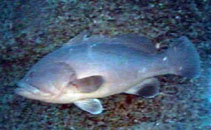| Family: |
Epinephelidae (Groupers) |
| Max. size: |
230 cm TL (male/unsexed); max.weight: 198 kg; max. reported age: 91 years |
| Environment: |
demersal; marine; depth range 55 - 525 m, oceanodromous |
| Distribution: |
Western Atlantic: Massachusetts, USA to the Gulf of Mexico, Cuba, Trinidad, Rio de Janeiro and Sao Paulo (Ref. 47377), Brazil. Rare in the West Indies (Cuba, Haiti, and Trinidad). Reports from the eastern Pacific are apparently misidentifications of Epinephelus exsul. |
| Diagnosis: |
Dorsal spines (total): 10-10; Dorsal soft rays (total): 13-15; Anal spines: 3-3; Anal soft rays: 9-9. Distinguished by the following characteristics: dark reddish brown or brownish grey to almost black dorsally, dull reddish grey below; depth of body contained 2.4-2.6 times in SL; head length 2.1-2.5 times in SL; distinctly convex interorbital area; angular preopercle, rounded angle, with slightly enlarged serrae and with 1-2 small spines on lower edge just in front of angle; smooth interopercle and subopercle; subequal nostrils, posterior nostrils slightly larger; maxilla reaches well past eye; 4-5 rows of small teeth on midside part of lower jaw in adults and juveniles with 2-3 rows (Ref. 89707). |
| Biology: |
A solitary species (Ref. 26340) usually found on rocky bottoms; juveniles are occasionally seen on jetties and shallow reefs (Ref. 89707). Adults feed on a variety of crabs, shrimps, lobsters, and fishes. Marketed fresh. |
| IUCN Red List Status: |
Near Threatened (NT); Date assessed: 21 November 2016 Ref. (130435)
|
| Threat to humans: |
harmless |
Source and more info: www.fishbase.org. For personal, classroom, and other internal use only. Not for publication.
